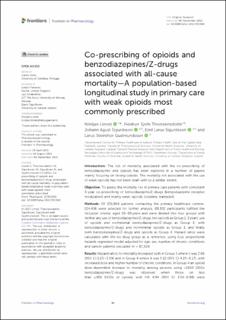| dc.contributor.author | Linnet, Kristjan | |
| dc.contributor.author | Thorsteinsdottir, Heidrun Sjofn | |
| dc.contributor.author | Sigurdsson, Johann Agust | |
| dc.contributor.author | Sigurdsson, Emil Larus | |
| dc.contributor.author | Gudmundsson, Larus Steinthor | |
| dc.date.accessioned | 2023-03-03T07:08:07Z | |
| dc.date.available | 2023-03-03T07:08:07Z | |
| dc.date.created | 2022-11-09T10:58:50Z | |
| dc.date.issued | 2022 | |
| dc.identifier.citation | Frontiers in Pharmacology. 2022, 13 . | en_US |
| dc.identifier.issn | 1663-9812 | |
| dc.identifier.uri | https://hdl.handle.net/11250/3055570 | |
| dc.description.abstract | Introduction: The risk of mortality associated with the co-prescribing of benzodiazepines and opioids has been explored in a number of papers mainly focusing on strong opioids. The mortality risk associated with the use of weak opioids has not been dealt with to a similar extent.
Objective: To assess the mortality risk in primary care patients with consistent 3-year co-prescribing of benzodiazepine/Z-drugs (benzodiazepine receptor modulators) and mainly weak opioids (codeine, tramadol).
Methods: Of 221,804 patients contacting the primary healthcare centres, 124,436 were selected for further analysis, 88,832 participants fulfilled the inclusion criteria, aged 10–69 years and were divided into four groups with neither any use of benzodiazepines/Z-drugs nor opioids as Group 1, 3 years’ use of opioids and no/minimal benzodiazepines/Z-drugs as Group 2, with benzodiazepines/Z-drugs and no/minimal opioids as Group 3, and finally both benzodiazepines/Z-drugs and opioids as Group 4. Hazard ratios were calculated with the no-drug group as a reference, using Cox proportional hazards regression model adjusted for age, sex, number of chronic conditions and cancer patients excluded (n = 87,314).
Results: Hazard ratios for mortality increased both in Group 3 where it was 2.66 (95% CI 2.25–3.09) and in Group 4 where it was 5.12 (95% CI 4.25–6.17), with increased dose and higher number of chronic conditions. In Group 4 an opioid dose-dependent increase in mortality among persons using >1000 DDDs benzodiazepines/Z-drugs was observed when those on less than ≤300 DDDs of opioids with HR 4.94 (95% CI 3.54–6.88) were compared to those on >300 DDDs with HR 7.61/95% CI 6.08–9.55). This increase in mortality was not observed among patients on <1000 DDDs of benzodiazepines/Z-drugs.
Conclusion: The study supports evidence suggesting that mortality increases in a dose-dependent manner in patients co-prescribed benzodiazepines/Z-drugs and weak opioids (codeine, tramadol). An association between the number of chronic conditions and a rise in mortality was found. Long-term use of these drugs should preferably be avoided. Non-pharmacological therapy should be seriously considered instead of long-term use of benzodiazepines/Z-drugs, and deprescribing implemented for chronic users of these drugs when possible. | en_US |
| dc.language.iso | eng | en_US |
| dc.publisher | Frontiers Media | en_US |
| dc.rights | Navngivelse 4.0 Internasjonal | * |
| dc.rights.uri | http://creativecommons.org/licenses/by/4.0/deed.no | * |
| dc.title | Co-prescribing of opioids and benzodiazepines/Z-drugs associated with all-cause mortality—A population-based longitudinal study in primary care with weak opioids most commonly prescribed | en_US |
| dc.title.alternative | Co-prescribing of opioids and benzodiazepines/Z-drugs associated with all-cause mortality—A population-based longitudinal study in primary care with weak opioids most commonly prescribed | en_US |
| dc.type | Peer reviewed | en_US |
| dc.type | Journal article | en_US |
| dc.description.version | publishedVersion | en_US |
| dc.source.volume | 13 | en_US |
| dc.source.journal | Frontiers in Pharmacology | en_US |
| dc.identifier.doi | 10.3389/fphar.2022.932380 | |
| dc.identifier.cristin | 2071091 | |
| cristin.ispublished | true | |
| cristin.fulltext | original | |
| cristin.qualitycode | 1 | |

